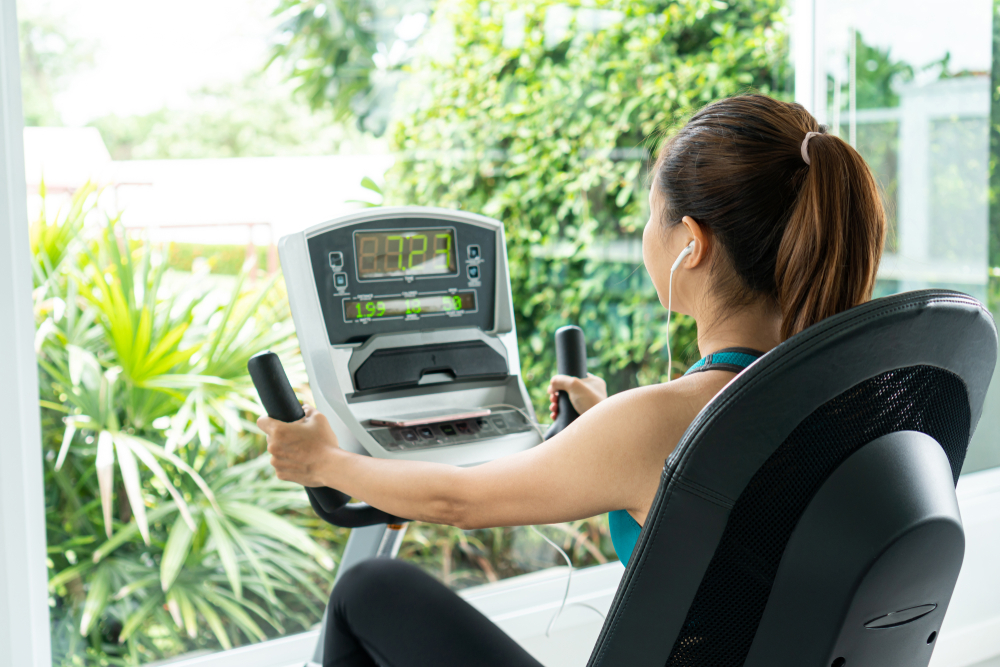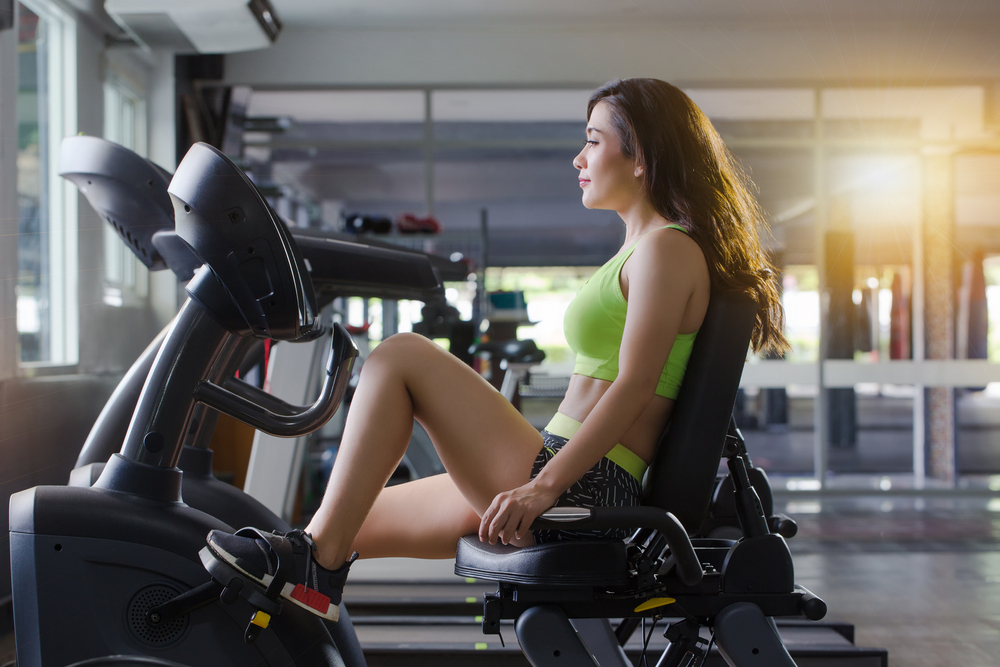Yes—recumbent bikes can help you lose weight if you ride often enough and at an intensity that creates a calorie deficit.
Keep reading for a clear breakdown of how they compare to upright bikes, what the research says, and exactly how to structure your workouts for results.
How Recumbent Bikes Burn Calories and Support Fat Loss
A recumbent bike burns calories the same way any cardio does: you supply power, your muscles use oxygen, and your body expends energy.
What changes with the reclined posture is how much peak power you can reach and how easy it feels to keep going—two factors that shape your total weekly burn.
The engine of calorie burn: oxygen and power
Cardio expenditure tracks closely with oxygen use: you burn roughly 5 kcal for every liter of oxygen consumed.
That relationship holds whether you’re on a recumbent or an upright.
If you ride at the same intensity (same VO₂ or equivalent power) for the same time, you’ll end up with similar calories.
Think of power or heart rate as your dials—match them across bikes and the energy cost lines up.
Why recumbents can show slightly lower calories per minute
Lab work comparing postures shows people often reach a higher “top end” on upright bikes—higher peak VO₂ and peak power—so minute-to-minute burn can be a touch lower on a recumbent at maximal efforts.
That doesn’t make the workout less useful; it just means you may need to ride a bit longer or nudge the resistance up to match the total calories you’d see upright.
In practice, many riders find they can’t sustain those upright peaks for long anyway, so the recumbent’s steady, sustainable output often wins over a full week.
Comfort and low impact turn consistency into results
A supported back, open hip angle, and low joint load make recumbent sessions feel easier at the same absolute workload.
Perceived effort often reads lower, especially below max, which helps you stay on the pedals longer and show up more often.
That steady adherence—more total minutes at a workable intensity—is what creates the calorie deficit that drives weight loss over time.
Make the math work in real workouts
You don’t need lab gear to translate this into action. Use whichever metric your bike shows—power, heart rate, or RPE—and pair it with time.
For example, a 45-minute ride averaging 150 W yields about 405 kJ of mechanical work; with typical cycling efficiency, that’s roughly 440 kcal of metabolic cost.
If your recumbent tops out sooner than an upright, extend the session 5–10 minutes or add a small resistance bump to keep weekly calories in range.
Remember that console calorie readouts are estimates; the reliable target is accumulating enough weekly work (time × intensity) and progressing it gradually.
Simple levers to raise your burn on a recumbent
- Hold a steady cadence in the 60–90 rpm range and increase resistance until breathing is clearly elevated yet sustainable.
- Add short, controlled surges (for instance, 30–60 seconds harder every few minutes) to push average power up without spiking joint stress.
- Use RPE as a backstop: aim for a “can talk in short phrases” effort for most of the ride, with periodic harder efforts where talking is tough.
- Track weekly minutes and average effort; bump one of them slightly every week or two to keep progress moving.
- Favor the bike you’ll use most days; comfort that keeps you riding is a tangible calorie advantage.
Recumbent vs Upright Bikes: What the Research Shows
A change in posture changes how high you can push and how the work feels, but not the basic physics of calorie burn.
Here’s what lab findings mean for your plan, plus simple ways to test which setup helps you rack up more useful work each week.
Peak capacity: upright bikes usually allow higher “top end”
Studies consistently find higher peak VO₂ and peak power on upright bikes.
You can often sprint harder and hit bigger numbers before you run out of gas.
Recumbents still support vigorous work; you may just top out a bit sooner.
For weight loss, this matters only if your routine lives near max.
Most riders spend more time in moderate to hard zones, where total minutes and sustainable output drive results.
Submax work: both bikes can hit the right zones
At everyday training intensities, posture changes some physiological responses, but you can still reach moderate and vigorous zones on a recumbent.
If you can hold a conversational pace with steady, elevated breathing for 45–60 minutes, you’re in the right ballpark for moderate work; if speaking in short phrases gets tough during intervals, you’re in vigorous territory.
Match time and effort across bikes and your calories come out comparable.
Perceived effort: recumbents often feel easier at the same load
At the same absolute resistance, people often report lower RPE on recumbents, thanks to back support and joint comfort.
That “feels easier” effect can help you go longer or return more often, which raises weekly calorie totals.
Near all-out efforts, the RPE gap shrinks, so use comfort to extend steady sessions or to recover faster between hard repeats rather than chasing max numbers alone.
Muscle activation: you’re training the same engine
EMG work shows very similar lower-limb activation patterns between upright and recumbent cycling at moderate loads.
You’re still asking quads, glutes, and calves to produce the work that burns calories.
Core demand differs a little with posture, but for fat loss the main movers are doing the job in both setups.
Put the research to work: a quick two-ride comparison
- Do a 10-minute warm-up, then ride 20 minutes at RPE ~6–7/10 on Bike A. Log average heart rate, power (if available), and how you felt in the last five minutes.
- Rest a day, repeat on Bike B at the same perceived effort.
- Pick the bike where you can hold a higher average power at the same RPE—or, if power isn’t shown, the one that lets you comfortably extend the session 5–10 minutes without extra strain. That choice usually yields more weekly work with less friction.
The Weekly Workout Volume That Actually Moves the Scale
A recumbent bike will only move the scale if your weekly riding time is high enough to create a real calorie deficit.
The science is clear on how much is “enough,” and you can shape that time in different ways to fit your schedule and preferences.
Understanding the time–result relationship
Research on weight loss and cardio consistently points to a simple pattern: the more total time you spend in effective heart-rate zones each week, the more likely you are to lose fat—assuming your diet supports a deficit.
Around 150–250 minutes of moderate-intensity cardio per week can lead to modest weight loss.
Pushing beyond 250 minutes tends to produce more noticeable, clinically meaningful reductions in body fat.
For recumbent riders, a realistic and sustainable target is 200–300 minutes each week.
This range balances the slightly lower peak output of the posture with enough total work to drive results.
You don’t need to cram this into long, grueling rides—splitting the total over multiple days makes it easier to maintain.
Structuring your week for weight loss
One effective approach is to spread those minutes over 4–6 sessions.
A few longer, steady rides build your aerobic base and burn steady calories, while shorter, harder sessions help boost your fitness and increase the total weekly burn.
For example, you might do two interval sessions and three or four moderate rides, adjusting based on recovery and time availability.
It’s worth noting that the “moderate” category isn’t about barely pedaling—it means your breathing is noticeably faster, but you can still speak in short sentences.
Vigorous intensity, which counts double toward your weekly goal in exercise guidelines, is where conversation becomes difficult and your breathing is heavy but controlled.
You can mix both intensities to reach your total.
Why weekly totals matter more than single rides
A single intense workout may burn a lot of calories, but your body responds to the cumulative effect of multiple rides.
Consistency keeps your average energy expenditure high and prevents the common cycle of “big session, long break.”
The weekly target gives you flexibility: if you miss a day, you can make up time with slightly longer rides later in the week without losing momentum.
Adjusting over time
If your weight loss stalls after a few weeks, gradually increase total weekly minutes by about 10%—that might mean adding one extra ride, extending two sessions by 10 minutes, or making an easy day slightly more challenging.
The key is steady, measurable progression rather than sudden leaps that risk burnout or injury.
When you view your training in terms of total weekly volume, the recumbent bike becomes a flexible tool—you can mix ride lengths, intensities, and recovery days to keep hitting your numbers without the discomfort that can derail consistency.
Over weeks and months, it’s those accumulated minutes, not any single “killer” workout, that drive sustainable fat loss.
Proven Recumbent Bike Interval Structures for Faster Results

A well-structured interval plan lets a recumbent deliver the same fitness and fat-loss benefits you’d expect from an upright.
These sessions work because they raise average work during the ride and create a modest after-burn while building the engine you need for longer, more productive weeks.
Why intervals on a recumbent work
HIIT protocols translate cleanly to the recumbent position.
Short, hard bouts push oxygen use and power higher than steady riding, which raises total calories for the session and slightly elevates post-exercise expenditure.
Comfort and back support often make it easier to maintain quality across repeats, so you collect more useful minutes in vigorous zones without beating up your joints.
How to run each session (warm-up, execute, cool-down)
Start with 8–12 minutes of easy pedaling, gradually increasing resistance until breathing is clearly elevated.
During work bouts, hold a steady cadence in the 60–90 rpm range and use resistance to reach the target effort. Finish with 5–10 minutes easy plus gentle leg mobility.
Use whichever anchor you have—heart rate, power, or RPE—and keep targets consistent across weeks so progress is obvious.
Three proven interval templates
- 4 × 4 minutes hard, 3 minutes easy between
Ride the hard segments at 85–95% HRmax (about RPE 8/10). Newer riders can begin with 2–3 reps and build to 4. Aim to keep cadence smooth and breathing strong but controllable. - 10 × 1 minute very hard, 1 minute easy
Target RPE 9/10 for the work minutes. This format fits busy days and teaches you to handle high resistance without losing form. - 30-20-10 blocks (5 minutes each), recover 2–3 minutes; do 3–5 blocks
Cycle 30 s easy, 20 s moderate, 10 s all-out. The frequent pace changes drive intensity while keeping the session mentally engaging.
Picking targets when you don’t have lab tools
Heart-rate users can think in zones: moderate rides sit near 64–76% HRmax, while the intervals above live in vigorous territory.
Power users can track average watts across the hard segments and try to hold or slightly improve that number week to week.
If your console shows neither, RPE works: moderate feels like speaking in short sentences; vigorous pushes you into single words.
Progression that respects recovery
Increase only one lever at a time every 1–2 weeks: add a rep, trim a minute from recovery, or nudge resistance to raise average power a touch.
Keep the total hard time increase modest (about 10% or less). Plan an easier week every 3–4 weeks where you cut interval volume in half while keeping the routine, so adaptations consolidate.
Where intervals fit in your week
Two interval days paired with several moderate steady rides is a reliable structure for fat loss.
Space the hard days at least 48 hours apart when possible, and avoid stacking them right before your longest steady ride.
If life gets busy, keep one interval day and add minutes to a steady session to protect weekly totals.
Technique and comfort tips for higher quality efforts
Set the seat so your knee is roughly 25–35° flexed at the far end of the stroke, keep your back fully supported, and relax your shoulders.
Drive through the mid-foot and keep knees tracking in line with the pedals.
Those simple cues let you push harder without spikes in joint stress, which helps you sustain intensity across all intervals.
What success looks like on paper
Across a month, you should see one or more of the following: slightly higher average power at the same RPE, shorter recoveries with equal quality, or the ability to add one interval without fading.
Pair those wins with steady weekly minutes and you’ll raise total calorie expenditure while your fitness climbs—exactly what moves the scale.
Steady-State Rides and Calorie Targets That Work
Steady rides are where you quietly stack calories and fitness without beating up your joints.
Lock in a repeatable setup, hit a sensible weekly calorie target, and nudge the workload up every few weeks.
Aim for 45–60 minutes at a conversational pace—roughly 64–76% of HRmax—while holding a smooth 60–90 rpm cadence.
Use resistance to keep breathing clearly elevated yet sustainable; if you can chat in short sentences, you’re in the right spot.
This intensity keeps lactate under control, lets you rack up time, and leaves enough in the tank for interval days.
Plan your week around a cycling calorie target of 1,200–2,000 kcal as part of your overall deficit.
That might look like four or five 45–60 minute steady rides plus one or two interval sessions, depending on your size and fitness.
Treat console readouts as rough guidance only—machines can over- or underestimate—so anchor your plan to total minutes and how the work feels (RPE) or to average power if your bike shows it.
Make tracking simple and consistent. For each steady ride, note duration, average heart rate (or RPE), and, if available, average watts.
Over a week, your totals should show enough time in that moderate zone to reach your calorie goal.
If your average power climbs a bit at the same RPE, you’re getting more work for the same perceived cost—exactly what you want.
Progress in small, predictable steps every 2–3 weeks. Add 5–10 minutes to two rides, or raise resistance slightly to lift average power while keeping cadence in the 60–90 rpm window.
You can also keep time fixed and bump average watts a touch; the key is to move one variable at a time so you can see what actually drives improvement.
If you like concrete targets, start with three 50-minute steady rides and one 60-minute ride this week, then check your total: does it land near your chosen 1,200–2,000 kcal range?
If not, extend a session by 10 minutes or add a short extra ride.
Small adjustments compound, and steady minutes at the right intensity are the most reliable way to turn your recumbent time into real weight loss.
Comfort, Fit, and Adjustments That Keep You Riding
Good fit turns your recumbent into something you want to ride often, which is exactly what drives weekly minutes and fat loss.
Small tweaks to seat position, back support, and pedaling mechanics make longer sessions feel natural instead of forced.
Set the seat so your knee is about 25–35° flexed at the far end of the pedal stroke.
This usually means sliding the seat until your leg is nearly straight at full extension without locking the knee.
Keep your back fully supported on the seat, let the shoulders relax, and hold the handles lightly so the upper body stays calm while the legs do the work.
That posture lets you push resistance safely for longer blocks, increasing total calories over the week.
Think of comfort as a performance feature.
A supported spine and open hip angle reduce joint stress, which makes it easier to ride more days and stretch steady sessions to 45–60 minutes.
If you deal with knee or back pain, a recumbent’s low-impact position reduces load on knees and spine while still delivering effective cardio.
Start with moderate resistance and a smooth cadence, then build time and intensity as comfort allows.
A quick setup checklist helps you dial things in fast.
Sit tall with your hips all the way back against the seat and adjust the seat distance before you touch resistance.
Knees should track in line with the pedals rather than collapsing inward or flaring out.
Place the mid-foot over the pedal spindle and secure straps just snug enough to prevent slipping without creating hot spots.
Pick a cadence in the 60–90 rpm range and use resistance—not choppy cadence—to set effort.
If something hurts or feels off, make one change at a time and reassess within a few minutes.
Achy front-of-knee sensations often ease with a small increase in seat distance to reduce knee bend at the top of the stroke.
Tight hamstrings or low-back fatigue can improve with a slightly more upright backrest angle and a short cadence reset at easier resistance.
Foot numbness usually responds to loosening straps a notch and wiggling toes during recovery sections.
Consistent cooling (fan on you) and a bottle within reach also matter more than most people expect during longer rides.
Technique stays simple once fit is right. Drive smoothly through the whole circle, keeping pressure consistent rather than stomping.
Let the breath guide your pacing—steady and elevated for most of the ride, deeper and more forceful during surges or intervals.
Check in every 10 minutes: relaxed shoulders, stable hips, knees tracking straight, cadence smooth.
Those cues protect joints, keep RPE honest, and make it easier to add the minutes and resistance increases that move progress forward.
Conclusion
A recumbent bike can absolutely support weight loss when you ride often enough and at an effort that keeps weekly calories in the right range.
Matching smart training—steady rides, intervals, and gradual progression—with good fit and comfort ensures you can keep showing up.
Over time, it’s that consistency, not any single workout, that delivers lasting results.







